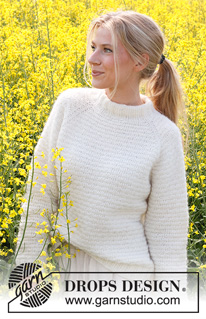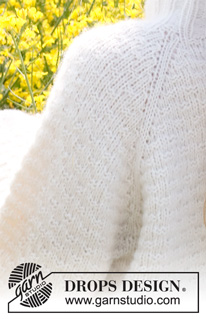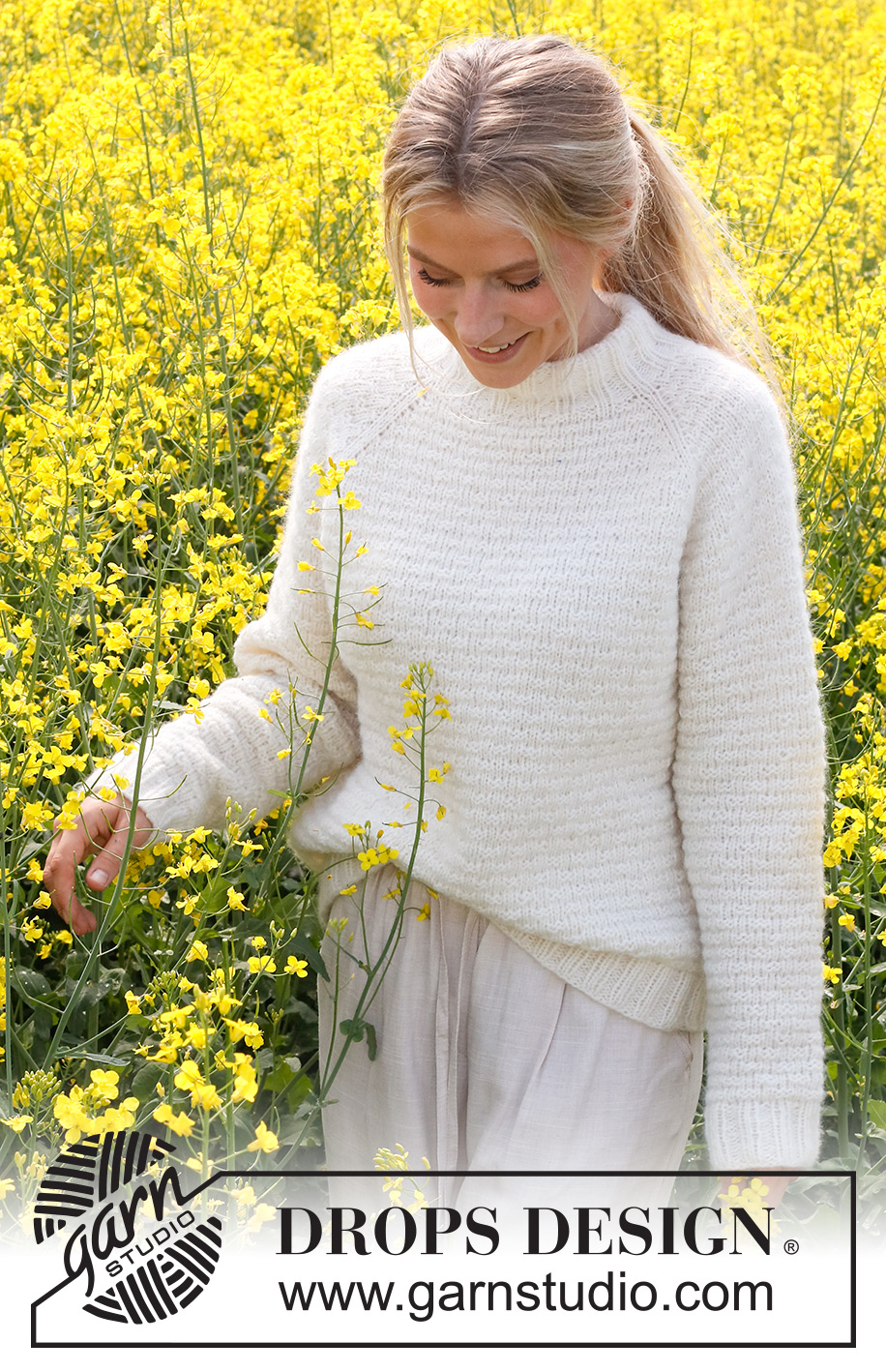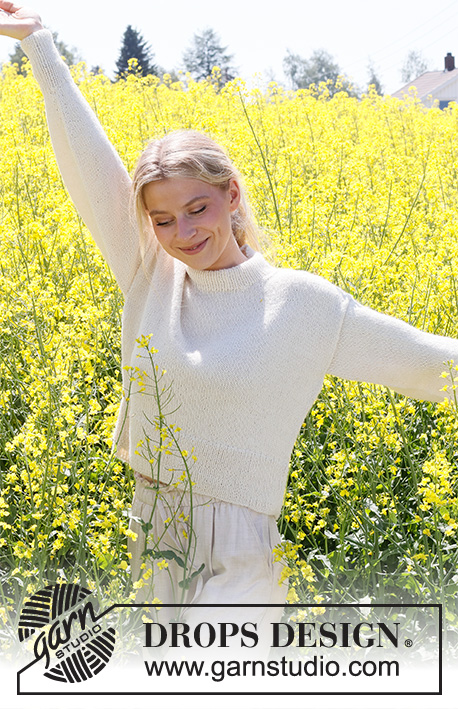Comments / Questions (31)
![]() Beginner wrote:
Beginner wrote:
I am confused with markers. Can you specify which marker that I need to make the decrease for the body? I am currently have 6 markers.
26.01.2025 - 06:57DROPS Design answered:
Hi, for decrease on body you need insert 1 marker in the middle of the cast-on stitches under each sleeve (= sides of body). These are the markers that we need for decreasing on body. Happy knitting!
26.01.2025 - 11:52
![]() ALISON wrote:
ALISON wrote:
Is the Raglan increase (eg row 2) K YO P P K K P P K.... or K YO P K K P P K ie does pattern repeat of A1 include the YO or not? Can't get the raglan line neat.
09.08.2024 - 19:55DROPS Design answered:
Dear Alison, the increases are right before and right after A.1, and these are worked inside the pattern on the next and following rounds. The pattern is: knit 2, purl 2, which are worked alternately and start at different marks in rounds 1 and 2 and rounds 5 and 6 of the charts. So the increased stitches will be purled or knitted depending on the stitches around it; for example, at the beginning you have knit 1, so the first increase would be knitted. But the next 2 increased stitches at the beginning of the round will be purled. Happy knitting!
11.08.2024 - 13:54
![]() Bian wrote:
Bian wrote:
Hi Ich verstehe nicht, wie ich die neuen Maschen ins Muster aufnehmen soll. Schon in der 1. Zunahme passt das Muster nicht,oder? Ich stricke ja 1re,2 li,1 re, mit der Zunahme würde sich das Muster verschieben, oder?
15.07.2024 - 19:57DROPS Design answered:
Guten Tag, Sie stricken das begonnene Muster passend übereinander weiter, sodass sich nichts verschiebt, und ergänzen dann die neuen Maschen so, wie es zum Muster passt, also als neuen Mustersatz. Vielleicht markieren Sie sich den ersten und den letzten kompletten Mustersatz, dann sehen Sie leichter, wo ein neuer Mustersatz beginnt. Am Anfang ist der natürlich noch nicht vollständig, sondern erst nach 4 Raglanzunahmen haben Sie wieder 4 Maschen, die Sie für einen neuen kompletten Mustersatz benötigen. Gutes Gelingen!
21.07.2024 - 16:31
![]() Hanna wrote:
Hanna wrote:
På "Fram och Bakstycke" är min fråga hur många markörer ska jag ha totalt på varvet? Ska jag fortsätta med slätstickning vid markörerna hela tröjan ut? Det ser inte ut så på bilderna...
04.07.2024 - 04:08DROPS Design answered:
Hej Hanna, når du er færdig med raglanudtagningerne på bærestykket, sætter du 1 mærke i hver side (under armen). De 2 masker på hver side af mærket i hver side strikkes i glatstrik. Mønsteret fortsætter du over alle de andre masker på forstykket og bagstykket :)
04.07.2024 - 07:50
![]() Mallorca wrote:
Mallorca wrote:
Las fotos, las tallas de S a XXXL y el patrón del dibujo corresponden a un modelo, pero las indicaciones del tejido corresponden a otro modelo con talla XS a XL. No me he vuelto loca de milago. Es un patrón imposible.
01.03.2024 - 01:46
![]() Lily wrote:
Lily wrote:
Hello. I started knitting it and I have a question. Does "knit 12 stitches in pattern A1" mean stitches or pattern repeats? Do I have to knit 1
12.01.2024 - 09:59DROPS Design answered:
Dear Lily, this means you will have to repat the 4 sts in diagram A.1 a total of 3 times (read diagram from the bottom corner on the right side upwards on every round). Happy knitting!
12.01.2024 - 13:42
![]() Iselin wrote:
Iselin wrote:
Når den sier at jeg skal strikke 12 ganger i mønster, skal jeg da starte med rettstrikkingen fra bunnen slik den viser i A.1? Føler ikke jeg får med mye møster da i 12 masker😅 mhv en nybegynner
29.12.2023 - 23:01DROPS Design answered:
Hei Iselin. Første gang du skal strikke A.1, starter du på 1. rad. Strikk 12 masker av A.1 (A.1 strikkes da 3 ganger), strikk 2 masker glattstrikk, strikk 24-24-28-32-32 eller 36 masker i mønster A.1 (forstykket). Du starter på 1. rad og 1. maske du ser i diagrammet. I str. S og M strikkes da A.1 6 ganger, mens i str. L 7 ganger, XL og XXL 8 ganger og i str. XXL 9 ganger. Følg oppskriften og start alltid med 1. maske på 1. rad, strikk omgangen ut. Og når du starter på 2. omgang strikker du 2. pinne i diagrammet osv. mvh DROPS Design
08.01.2024 - 13:50
![]() Birgit Eklund Pedersen wrote:
Birgit Eklund Pedersen wrote:
Hej, mangler der ikke noget tekst i afsnittet om udtagning til raglan? \r\nSkal jeg slå om henholdsvis før de 2 retmasker og efter de 2 retmasker, altså inden sidste maske før mærket og efter første maske efter mærket?\r\nVenlig hilsen birgit
07.11.2023 - 18:42DROPS Design answered:
Hei Birgit. I forklaringen står det at du skal strikke 1 maske forbi 1. merke, gjør et kast, strikk til det gjenstår 1 maske før det neste merke, gjør et kast = 1 kast etter en maske med merke og 1 kast før en maske med merke. Og slik økes det ved hvert merke. = 8 kast på 1 omgang. Hadde starten på omgangen vært midt bak så kunne man ha skrevet slik du skriver, men i denne oppskriften er omgangens start ved overgangen mellom 1/2 bakstykket og et erme. mvh DROPS Design
13.11.2023 - 10:16
![]() Hanh Nguyen wrote:
Hanh Nguyen wrote:
I didn’t understand instruction in yoke measure: each sleeve: 14sts; front piece & back piece : 26 sts eacch; total 80sts at begin. After 21 times of increase for raglan, 8sts increased for each row, mean 2 sts increased inside each sleeve how finally we got 48 sts for each sleeve on devision? Can anybody help me ? TIA.
25.08.2023 - 13:58DROPS Design answered:
Dear Mrs Nguyen, the first 3 sts + the last 3 sts on each sleeve will belong to back/front piece - you started with 12 sts for each sleeve, then increased 21 times = 54 sts - 6 sts (3 on each side for front/back piece) = 48 sts. Happy knitting!
28.08.2023 - 12:53
![]() Emmy wrote:
Emmy wrote:
I am having trouble understanding the raglan increases. Should I increase on both sides of the marker, a total of 8 times per row?
31.07.2023 - 10:38DROPS Design answered:
Dear Emmy, increase on each side of the 2 raglan stitches worked in stocking stitch (with the markers in the middle), so at the beg of the round, K1 and increase for raglan, then work until 1 st remain before next marker, make 1 YO, K2 (marker is between these 2 sts), make 1 YO, repeat these at the next markers until 1 stitch remain before the end of the round, make 1 YO and knit the last stitch. You have increased 2 sts on each piece, ie a total of 8 sts. Repeat these increases on every other round. Happy knitting!
31.07.2023 - 11:51
Provence Dream#provencedreamsweater |
|||||||
 |
 |
||||||
Knitted sweater in DROPS Air. The piece is worked top down with raglan, moss stitch and double neck. Sizes S - XXXL.
DROPS 230-15 |
|||||||
|
------------------------------------------------------- EXPLANATIONS FOR THE PATTERN: ------------------------------------------------------- PATTERN: See diagram A.1. RAGLAN: Increase to raglan on each side of the 2 knitted stitches at each marker: Work 1 stitch past the first marker, make 1 yarn over. Work until there is 1 stitch left before the next marker, make 1 yarn over. Increase like this at each marker. The increased stitches are knitted twisted on the next round then worked into the pattern. DECREASE TIP: Decrease 1 stitch on each side of the marker as follows: Work until there are 3 stitches left before the marker, knit 2 together, knit 2 (marker sits between these 2 stitches), slip 1 stitch as if to knit, knit 1 and pass the slipped stitch over the knitted stitch. ------------------------------------------------------- START THE PIECE HERE: ------------------------------------------------------- SWEATER – SHORT OVERVIEW OF THE PIECE: The neck and yoke are worked in the round with circular needle, top down. The yoke is divided for the body and sleeves and the body is continued in the round. The sleeves are worked in the round, with short circular needle/double pointed needles, top down. DOUBLE NECK: Cast on 100-100-110-120-120-130 stitches with circular needle size 4.5 MM = US 7 and DROPS Air. Work rib in the round (knit 3, purl 2) for 4 cm = 1½". Work the next round and decrease as follows: * Knit 1, knit 2 together, purl 2 *, work from *-* to the end of the round = 80-80-88-96-96-104 stitches. Continue the new rib (knit 2, purl 2) until the neck measures 16 cm = 6¼". Knit 1 round. YOKE: Change to circular needle size 5 MM = US 8. Insert 1 marker at the beginning of the round. The yoke is measured from this marker! Insert 4 markers while working the stitches as follows: Insert 1 marker at the beginning of the round, knit 1, work 12 stitches in pattern A.1 (sleeve), knit 2 and insert 1 marker between these 2 stitches, work 24-24-28-32-32-36 stitches in pattern A.1 (front piece), knit 2 and insert 1 marker between these 2 stitches, work 12 stitches in pattern A.1 (sleeve), knit 2 and insert 1 marker between these 2 stitches, work 24-24-28-32-32-36 stitches in pattern A.1 (back piece), knit 1. READ THE NEXT SECTION BEFORE CONTINUING! On the next round begin to increase to RAGLAN – read description above, while continuing with A.1. REMEMBER THE KNITTING GAUGE! Increase to raglan every 2nd round a total of 21-24-26-28-31-33 times = 248-272-296-320-344-368 stitches. Continue the pattern without further increases until the yoke measures 21-23-24-26-28-30 cm = 8¼"-9"-9½"-10¼"-11"-11¾" from the marker. Now divide for the body and sleeves as follows: Work 4-3-2-2-4-4 stitches (part of the back piece), place the next 48-56-62-66-68-72 stitches on a thread (sleeve), cast on 6-6-8-8-8-8 stitches under the sleeve, work 76-80-86-94-104-112 stitches (front piece), place the next 48-56-62-66-68-72 stitches on a thread (sleeve), cast on 6-6-8-8-8-8 stitches under the sleeve, work the last 72-77-84-92-100-108 stitches (a total of 76-80-86-94-104-112 stitches on the back piece). BODY: = 164-172-188-204-224-240 stitches. Insert 1 marker in the middle of the cast-on stitches under each sleeve. Continue in the round with pattern A.1. If the pattern does not fit under the sleeves, knit 2 stitches on each side of each marker; the other stitches should follow on from the pattern on the yoke. When the body measures 4 cm = 1½", decrease 1 stitch on each side of both markers - read DECREASE TIP. Repeat this decrease every 6-7-6-6-7-5 cm = 2⅜"-2¾"-2⅜"-2⅜"-2¾"-2" a total of 4-3-4-4-3-4 times = 148-160-172-188-212-224 stitches. Work until the body measures 25-25-26-26-25-25 cm = 9¾"-9¾"-10¼"-10¼"-9¾"-9¾" from the division - adjust to finish with 2 rounds of stockinette stitch (or to desired length, there is 5 cm = 2" left). Change to circular needle size 4 .5 MM = US 8 and work rib (knit 2, purl 2) for 5 cm = 2". Loosely bind off with knit over knit and purl over purl. The piece measures approx. 55-57-59-61-63-65 cm = 21⅝"-22½"-23¼"-24"-24¾"-25½" from the shoulder down. SLEEVES: Place the 48-56-62-66-68-72 stitches from the thread on the one side of the piece on short circular needle/double pointed needles size 5 MM = US 8 and knit up 1 stitch in each of the 6-6-8-8-8-8 stitches cast on under the sleeve = 54-62-70-74-76-80 stitches. Insert a marker in the middle of the 6-6-8-8-8-8 stitches under the sleeve. Start at the marker and work A.1 in the round. If the pattern does not fit under the sleeve, knit 2 stitches on each side of the marker, the other stitches continue the pattern from the yoke. When the sleeve measures 3 cm = 1⅛", decrease 2 stitches under the sleeve – remember DECREASE TIP. Decrease like this every 4-2½-1½-1½-1½-1 cm = 1½"-1"-½"-½"-½"-⅜" a total of 7-11-15-15-16-18 times = 40-40-40-44-44-44 stitches. Continue working until the sleeve measures 35-34-33-31-30-28 cm = 13¾"-13⅜"-13"-12¼"-11¾"-11" - adjust to finish with 2 rounds of stockinette stitch (or to desired length, there is approx. 5 cm = 2" left). Change to double pointed needles size 4.5 MM = US 7 and work rib (knit 2, purl 2) for 5 cm = 2". Loosely bind off with knit over knit and purl over purl. Work the other sleeve in the same way. ASSEMBLY: Fold the neck double to the inside and sew down. To avoid the neck being tight and rolling outwards, it is important that the seam is elastic. |
|||||||
Diagram explanations |
|||||||
|
|||||||

|
|||||||
Have you finished this pattern?Tag your pictures with #dropspattern #provencedreamsweater or submit them to the #dropsfan gallery. Do you need help with this pattern?You'll find 24 tutorial videos, a Comments/Questions area and more by visiting the pattern on garnstudio.com. © 1982-2025 DROPS Design A/S. We reserve all rights. This document, including all its sub-sections, has copyrights. Read more about what you can do with our patterns at the bottom of each pattern on our site. |
|||||||








































































Post a comment to pattern DROPS 230-15
We would love to hear what you have to say about this pattern!
If you want to leave a question, please make sure you select the correct category in the form below, to speed up the answering process. Required fields are marked *.